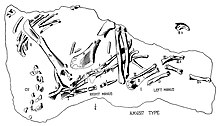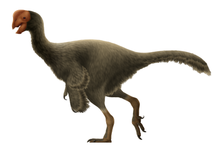Oviraptor
| Oviraptor | |
|---|---|

| |
| Holotype specimen of Oviraptor | |
| Scientific classification | |
| Domain: | Eukaryota |
| Kingdom: | Animalia |
| Phylum: | Chordata |
| Clade: | Dinosauria |
| Clade: | Saurischia |
| Clade: | Theropoda |
| Family: | †Oviraptoridae |
| Subfamily: | †Oviraptorinae |
| Genus: | †Oviraptor Osborn, 1924 |
| Type species | |
| †Oviraptor philoceratops Osborn, 1924
| |
| Synonyms | |
| |
Oviraptor (
Oviraptor was a rather small feathered oviraptorid, estimated at 1.6–2 m (5.2–6.6 ft) long with a weight between 33–40 kg (73–88 lb). It had a wide lower jaw with a skull that likely had a crest. Both upper and lower jaws were toothless and developed a horny beak, which was used during feeding along the robust morphology of the lower jaws. The arms were well-developed and elongated ending in three fingers with curved claws. Like other oviraptorids, Oviraptor had long hindlimbs that had four-toed feet, with the first toe reduced. The tail was likely not very elongated, and ended in a pygostyle that supported large feathers.
The initial relationships of Oviraptor were poorly understood at the time and was assigned to the unrelated Ornithomimidae by the original describer, Henry Osborn. However, re-examinations made by Rinchen Barsbold proved that Oviraptor was distinct enough to warrant a separate family, the Oviraptoridae. When first described, Oviraptor was interpreted as an egg-thief, egg-eating dinosaur given the close association of the holotype with a dinosaur nest. However, findings of numerous oviraptorosaurs in nesting poses have demonstrated that this specimen was actually brooding the nest and not stealing nor feeding on the eggs. Moreover, the discovery of remains of a small juvenile or nestling have been reported in association with the holotype specimen, further supporting parental care.
History of discovery
The first remains of Oviraptor were discovered on reddish

In 1976, the Mongolian paleontologist Rinchen Barsbold noted some inconsistencies regarding the taxonomic placement of Oviraptor and concluded that this taxon was quite distinct from ornithomimids based on anatomical traits. Under this consideration, he erected the Oviraptoridae to contain Oviraptor and close relatives.[3] After Osborn's initial description of Oviraptor, the egg nest associated with the holotype was accepted to have belonged to Protoceratops,[4][5] and oviraptorids were largely considered to have been egg-eating theropods.[6] Nevertheless, in the 1990s, the discovery of numerous nesting and nestling oviraptorid specimens proved that Osborn was correct in his caution regarding the name of Oviraptor. These findings showed that oviraptorids brooded and protected their nests by crouching on them. This new line of evidence showed that the nest associated with the holotype of Oviraptor belonged to it and the specimen was actually brooding the eggs at the time of death, not preying on them.[7][8][9]
Referred specimens

After the naming of Oviraptoridae in 1976, Barsbold referred six additional specimens to Oviraptor, including two particular specimens under the number MPC-D 100/20 and 100/21.[3] In 1986, Barsbold realized that the latter two did not belong to the genus and instead they represented a new oviraptorid: Conchoraptor.[10] Most of the other specimens are also unlikely to belong to Oviraptor itself, and they have been assigned to other oviraptorids.[11][12] A partial individual also with eggs from the Bayan Mandahu Formation of Mongolia was referred in 1996 by Dong Zhiming and Philip J. Currie, the specimen IVPP V9608.[9] However, in 2010 Nicholas R. Longrich and the two latter paleontologist have expressed their uncertainties regarding this referral as there are several anatomical differences such as the hand phalangeal proportions. They concluded that this specimen was a different and indeterminate species not referrable to this taxon.[13] In 1981, Barsbold referred the specimen MPC-D 100/42 to Oviraptor, a very well-preserved and rather complete individual from the Djadokhta Formation.[14] Since the known elements of Oviraptor were so fragmentary compared to other members, MPC-D 100/42 became the prime reference/depiction of this taxon being prominently labelled as Oviraptor philoceratops in scientific literature.[15][11]

This conception was refuted by
Description

The holotype specimen has been estimated at 1.6–2 m (5.2–6.6 ft) in length with a weight ranging from 33 to 40 kg (73 to 88 lb).
Skull

The
Postcranial skeleton

As in most oviraptords, the neural spines of the holotype
The furcula of Oviraptor is very distinct from other oviraptorids in having a midline keel on the anterior surface of the hypocleidium−a downwards directed projection at the center of the furcula. This bone is V-shaped, rounded in cross-section, preserves an elongate spike-like hypocleidium, and the interclavicular angle is about 90°.[26] The scapulocoracoid is fused in the holotype, however, the coracoid is badly damaged. The scapula is slightly bowed and measures 23 cm (230 mm) in length. Oviraptor had a relatively elongated arm composed of the humerus, radius, ulna, and manus.[1][25]

The phalangeal formula of Oviraptor was 2-3-4, as seen in most other theropods and oviraptorids. The hand of Oviraptor had three skinny and bird-like fingers with each finger ended in side to side flattened and recurved
Classification
Oviraptor was originally allied with the
The cladogram below follows an analysis by Gregory F. Funston and colleagues in 2020:[29]
Paleobiology
Feeding

When first described in 1924 by Osborn, Oviraptor was originally presumed to have been
In 2008, Stig Olav K. Jansen compared the skull of several oviraptorid species to those of
Longrich and colleagues in 2010 also rejected a
In 2018 however, Funston and colleagues supported the crushing jaw hypothesis. They pointed out that the stocky
Reproduction
Since the description of the
In 1999 Clark and team described in detail the previously reported Citipati nesting specimen and briefly discussed the holotype specimen of Oviraptor and its association with the nest AMNH 6508. They pointed out that the exact position in which the holotype was found over the nest is unclear as they were separated during preparation, and the nest appears to be not entirely complete with about 15 eggs preserved of which two damaged. Moreover, the semicircular arrangement of the nest indicates that the eggs were laid in pairs and in at least three rings, and this nest was originally circular, similar to a mound.[28]
Thomas P. Hopp and Mark J. Orsen in 2004 analyzed the brooding behavior of extinct and extant dinosaur species, including oviraptorids, in order to evaluate the reason for the elongation and development of wing and tail

In 2005, Tamaki Sato and team reported an unusual oviraptorid specimen from the
In 2018, Tzu-Ruei Yang and colleagues identified cuticle layers on several egg-shells of maniraptoran dinosaurs including those of oviraptorids. These particular layers are composed of proteins, polysaccharides and pigments, but mainly of lipids and hydroxyapatite. In modern birds they serve to protect the eggs from dehydration and invasion of microorganisms. As most oviraptorid specimens have been found in formations of caliche-based sedimentation, Yang and colleagues suggested that the cuticle-coated eggs would have been a reproductive strategy adapted for enhancing their hatching success in such arid climates and environments.[38]
In 2019 Yang and colleagues re-evaluated the hypothesis of
Paleoenvironment

Oviraptor is known from the Bayn Dzak locality of the
The Djadokhta Formation is separated into a lower Bayn Dzak Member and an upper Turgrugyin Member. The known remains of Oviraptor have been produced by the Bayn Dzak member, which has also yielded the dinosaurs
Taphonomy
The pose of the holotype of Oviraptor along with the association of eggs, suggest that it was trapped over the nest during a
See also
References
- ^ OCLC 40272928.
- ^ Osborn, H. F. (1924). "The discovery of an unknown continent". Natural History. 24 (2): 133−149.
- ^ theropodsOviraptoridae n. fam. in Mongolia]. Doklady Akademii Nauk SSSR. 226 (3): 685−688.
- ISBN 0-8137-2238-1.
- .
- doi:10.1139/e93-196.
- ^ S2CID 22333224.
- ^ S2CID 4245228.
- ^ doi:10.1139/e96-046.
- ^ a b Barsbold, R. (1986). "Хищные динозавры овирапторы" [Carnivorous dinosaurs oviraptors]. In Vorobyeva, E. I. (ed.). Herpetological research in the Mongolian People's Republic (in Russian). Institute of Evolutionary Morphology and Ecology of Animals: Doklady Akademii Nauk SSSR. pp. 210–223.
- ^ a b Maryańska, T.; Osmólska, H.; Wolsan, M. (2002). "Avialan status for Oviraptorosauria" (PDF). Acta Palaeontologica Polonica. 47 (1): 97−116.
- S2CID 40622976.
- ^ .
- S2CID 195060070. Translated paper
- ISBN 9780520067271.
- ^ S2CID 52247789.
- ^ Barsbold, 1997. Oviraptorosauria. In Currie and Padian (eds.). Encyclopedia of Dinosaurs. 505-509.
- ISBN 0520242092.
- ^ S2CID 53057001.
- PMID 23991160.
- ISBN 9780691167664.
- S2CID 221404013.
- PMID 22347465.
- ^ .
- ^ S2CID 86067306.
- PMID 19206153.
- S2CID 206871470.
- ^ hdl:2246/3102.
- PMID 33204472.
- ^ Barsbold, R. (1977). "Kinetism and peculiarity of the jaw apparatus of oviraptors (Theropoda, Saurischia)". Soviet-Mongolian Paleontological Expedition, Trudy. 4: 37−47. Translated paper
- .
- ^ Norell, M. A.; Gaffney, E. S.; Dingus, L. (1995). Discovering Dinosaurs In the American Museum of Natural History. Knopf Inc. p. 225.
- hdl:10852/11785.
- .
- ^ Hopp, T. P.; Orsen, M. J. (2004). "Dinosaur Brooding Behavior and the Origin of Flight Feathers" (PDF). In Currie, P. J.; Koppelhus, E. B.; Shugar, M. A.; Wright, J. L. (eds.). Feathered dragons: studies on the transition from dinosaurs to birds. Bloomington: Indiana University Press. pp. 234−250.
- S2CID 19470371.
- PMID 19095938.
- PMID 30002976.
- .
- ^ S2CID 55836458.
- ISBN 978-0-12-226810-6.
- ^ PMID 28724887.
- ^ S2CID 129735494.[permanent dead link]
- S2CID 4471941.
- ^ Alicea, J.; Loewen, M. (2013). "New Minotaurasaurus material from the Djodokta Formation establishes new taxonomic and stratigraphic criteria for the taxon". Journal of Vertebrate Paleontology. Program and Abstracts: 76. Archived from the original on 2020-11-01. Retrieved 2020-11-19.
- ISBN 9780253334978.


